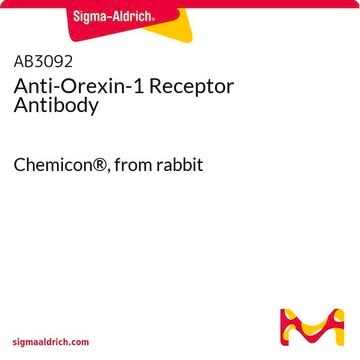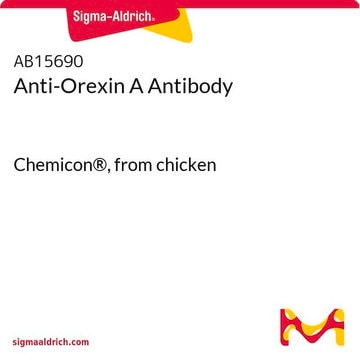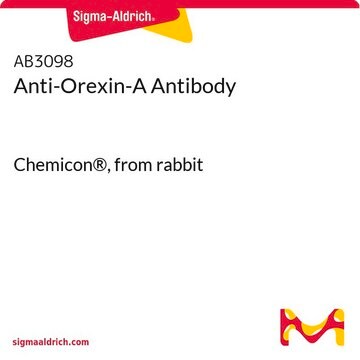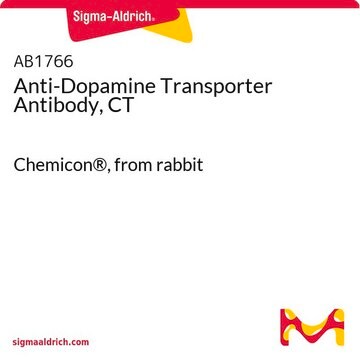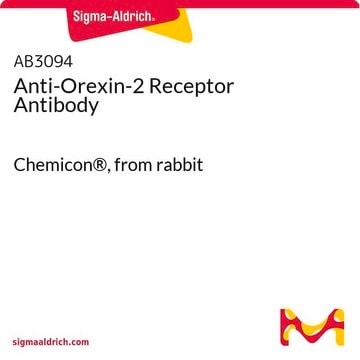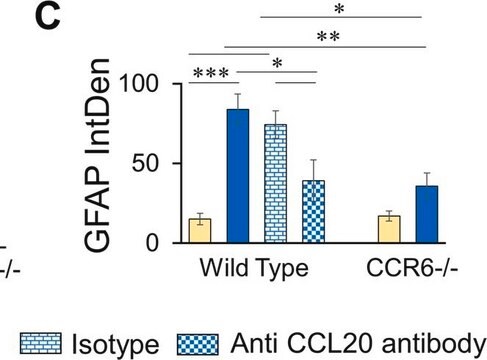AB3704
Anti-Orexin-A Antibody
serum, Chemicon®
Synonym(s):
Anti-NRCLP1, Anti-OX, Anti-PPOX
Sign Into View Organizational & Contract Pricing
All Photos(1)
About This Item
UNSPSC Code:
12352203
eCl@ss:
32160702
NACRES:
NA.41
Recommended Products
biological source
rabbit
Quality Level
antibody form
serum
antibody product type
primary antibodies
clone
polyclonal
species reactivity
rat
manufacturer/tradename
Chemicon®
technique(s)
immunohistochemistry: suitable
NCBI accession no.
UniProt accession no.
shipped in
dry ice
target post-translational modification
unmodified
Gene Information
human ... PPOX(5498)
Specificity
Orexin-A.
Immunogen
Synthetic peptide corresponding to the C-terminal portion of the bovine Orexin-A peptide.
Application
Detect Orexin-A using this Anti-Orexin-A Antibody validated for use in IH.
Immunohistochemistry: 1:1,000-1:2,000. The antibody shows intense labeling of Orexin-A neurons with low background.
Optimal working dilutions must be determined by end user.
Optimal working dilutions must be determined by end user.
Research Category
Neuroscience
Neuroscience
Research Sub Category
CNS Control of Metabolism
Circadian Rhythm & Sleep
CNS Control of Metabolism
Circadian Rhythm & Sleep
Physical form
Rabbit serum. Lyophilized. Reconstitute with 50 mL of sterile distilled water. Centrifuge to remove any insoluble material. Contains no preservative.
Storage and Stability
Maintain lyophilized material frozen at -20°C to -70°C for up to 12 months. After reconstitution maintain at -20°C in undiluted aliquots for up to 6 months. Avoid repeated freeze/thaw cycles. Glycerol (1:1, ACS or better grade) can be added for additional stability.
Legal Information
CHEMICON is a registered trademark of Merck KGaA, Darmstadt, Germany
Disclaimer
Unless otherwise stated in our catalog or other company documentation accompanying the product(s), our products are intended for research use only and are not to be used for any other purpose, which includes but is not limited to, unauthorized commercial uses, in vitro diagnostic uses, ex vivo or in vivo therapeutic uses or any type of consumption or application to humans or animals.
Not finding the right product?
Try our Product Selector Tool.
Storage Class Code
11 - Combustible Solids
WGK
WGK 1
Flash Point(F)
Not applicable
Flash Point(C)
Not applicable
Certificates of Analysis (COA)
Search for Certificates of Analysis (COA) by entering the products Lot/Batch Number. Lot and Batch Numbers can be found on a product’s label following the words ‘Lot’ or ‘Batch’.
Already Own This Product?
Find documentation for the products that you have recently purchased in the Document Library.
Hannah Bruguier et al.
The Journal of comparative neurology, 528(17), 2956-2977 (2020-04-09)
The human claustrum, a major hub of widespread neocortical connections, is a thin, bilateral sheet of gray matter located between the insular cortex and the striatum. The subplate is a largely transient cortical structure that contains some of the earliest
Chanpreet Singh et al.
eLife, 4, e07000-e07000 (2015-09-17)
Pharmacological studies in mammals suggest that norepinephrine (NE) plays an important role in promoting arousal. However, the role of endogenous NE is unclear, with contradicting reports concerning the sleep phenotypes of mice lacking NE due to mutation of dopamine β-hydroxylase
Organization and number of orexinergic neurons in the hypothalamus of two species of Cetartiodactyla: a comparison of giraffe (Giraffa camelopardalis) and harbour porpoise (Phocoena phocoena).
Dell, LA; Patzke, N; Bhagwandin, A; Bux, F; Fuxe, K; Barber, G; Siegel, JM; Manger, PR
Journal of Chemical Neuroanatomy null
Audrey Chen et al.
eNeuro, 4(1) (2017-03-10)
Pharmacological studies in mammals and zebrafish suggest that histamine plays an important role in promoting arousal. However, genetic studies using rodents with disrupted histamine synthesis or signaling have revealed only subtle or no sleep/wake phenotypes. Studies of histamine function in
Tanya Calvey et al.
Journal of chemical neuroanatomy, 70, 42-57 (2015-11-13)
The nuclear organization of the cholinergic, catecholaminergic, serotonergic and orexinergic systems in the brains of three species of strepsirrhine primates is presented. We aimed to investigate the nuclear complement of these neural systems in comparison to those of simian primates
Our team of scientists has experience in all areas of research including Life Science, Material Science, Chemical Synthesis, Chromatography, Analytical and many others.
Contact Technical Service
